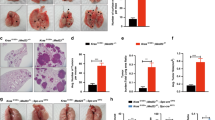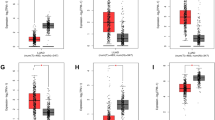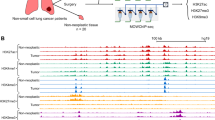Abstract
The conserved Myb-MuvB (MMB) multiprotein complex has an important role in transcriptional activation of mitotic genes. MMB target genes are overexpressed in several different cancer types and their elevated expression is associated with an advanced tumor state and a poor prognosis. This suggests that MMB could contribute to tumorigenesis by mediating overexpression of mitotic genes. However, although MMB has been extensively characterized biochemically, the requirement for MMB in tumorigenesis in vivo has not been investigated. Here we demonstrate that MMB is required for tumor formation in a mouse model of lung cancer driven by oncogenic K-RAS. We also identify a requirement for the mitotic kinesin KIF23, a key target gene of MMB, in tumorigenesis. RNA interference-mediated depletion of KIF23 inhibited lung tumor formation in vivo and induced apoptosis in lung cancer cell lines. Our results suggest that inhibition of KIF23 could be a strategy for treatment of lung cancer.
This is a preview of subscription content, access via your institution
Access options
Subscribe to this journal
Receive 50 print issues and online access
$259.00 per year
only $5.18 per issue
Buy this article
- Purchase on SpringerLink
- Instant access to full article PDF
Prices may be subject to local taxes which are calculated during checkout







Similar content being viewed by others
References
Carter SL, Eklund AC, Kohane IS, Harris LN, Szallasi Z . A signature of chromosomal instability inferred from gene expression profiles predicts clinical outcome in multiple human cancers. Nat Genet 2006; 38: 1043–1048.
Cheng W-Y, Ou Yang T-H, Anastassiou D . Biomolecular events in cancer revealed by attractor metagenes. PLoS Comput Biol 2013; 9: e1002920.
Chibon F, Lagarde P, Salas S, Pérot G, Brouste V, Tirode F et al. Validated prediction of clinical outcome in sarcomas and multiple types of cancer on the basis of a gene expression signature related to genome complexity. Nat Med 2010; 16: 781–787.
Sotillo R, Hernando E, Díaz-Rodríguez E, Teruya-Feldstein J, Cordón-Cardo C, Lowe SW et al. Mad2 overexpression promotes aneuploidy and tumorigenesis in mice. Cancer Cell 2007; 11: 9–23.
Díaz-Rodríguez E, Sotillo R, Schvartzman J-M, Benezra R . Hec1 overexpression hyperactivates the mitotic checkpoint and induces tumor formation in vivo. Proc Natl Acad Sci USA 2008; 105: 16719–16724.
Hernando E, Nahlé Z, Juan G, Díaz-Rodríguez E, Alaminos M, Hemann M et al. Rb inactivation promotes genomic instability by uncoupling cell cycle progression from mitotic control. Nature 2004; 430: 797–802.
Menssen A, Epanchintsev A, Lodygin D, Rezaei N, Jung P, Verdoodt B et al. c-MYC delays prometaphase by direct transactivation of MAD2 and BubR1: identification of mechanisms underlying c-MYC-induced DNA damage and chromosomal instability. Cell Cycle 2007; 6: 339–352.
Sadasivam S, DeCaprio JA . The DREAM complex: master coordinator of cell cycle-dependent gene expression. Nat Rev Cancer 2013; 13: 585–595.
Litovchick L, Sadasivam S, Florens L, Zhu X, Swanson SK, Velmurugan S et al. Evolutionarily conserved multisubunit RBL2/p130 and E2F4 protein complex represses human cell cycle-dependent genes in quiescence. Mol Cell 2007; 26: 539–551.
Schmit F, Korenjak M, Mannefeld M, Schmitt K, Franke C, Eyss von B et al. LINC, a human complex that is related to pRB-containing complexes in invertebrates regulates the expression of G2/M genes. Cell Cycle 2007; 6: 1903–1913.
Sadasivam S, Duan S, DeCaprio JA . The MuvB complex sequentially recruits B-Myb and FoxM1 to promote mitotic gene expression. Genes Dev 2012; 26: 474–489.
Osterloh L, Eyss von B, Schmit F, Rein L, Hübner D, Samans B et al. The human synMuv-like protein LIN-9 is required for transcription of G2/M genes and for entry into mitosis. EMBO J 2007; 26: 144–157.
Knight AS, Notaridou M, Watson RJ . A Lin-9 complex is recruited by B-Myb to activate transcription of G2/M genes in undifferentiated embryonal carcinoma cells. Oncogene 2009; 28: 1737–1747.
Esterlechner J, Reichert N, Iltzsche F, Krause M, Finkernagel F, Gaubatz S . LIN9, a subunit of the DREAM complex, regulates mitotic gene expression and proliferation of embryonic stem cells. PLoS ONE 2013; 8: e62882.
Reichert N, Wurster S, Ulrich T, Schmitt K, Hauser S, Probst L et al. Lin9, a subunit of the mammalian DREAM complex, is essential for embryonic development, for survival of adult mice, and for tumor suppression. Mol Cell Biol 2010; 30: 2896–2908.
Jackson EL, Olive KP, Tuveson DA, Bronson R, Crowley D, Brown M et al. The differential effects of mutant p53 alleles on advanced murine lung cancer. Cancer Res 2005; 65: 10280–10288.
DuPage M, Dooley AL, Jacks T . Conditional mouse lung cancer models using adenoviral or lentiviral delivery of Cre recombinase. Nat Protoc 2009; 4: 1064–1072.
Saville MK, Watson RJ . The cell-cycle regulated transcription factor B-Myb is phosphorylated by cyclin A/Cdk2 at sites that enhance its transactivation properties. Oncogene 1998; 17: 2679–2689.
García P, Berlanga O, Watson R, Frampton J . Generation of a conditional allele of the B-myb gene. Genesis 2005; 43: 189–195.
Tetreault M-P, Yang Y, Katz JP . Krüppel-like factors in cancer. Nat Rev Cancer 2013; 13: 701–713.
Kissil JL, Walmsley MJ, Hanlon L, Haigis KM, Bender Kim CF, Sweet-Cordero A et al. Requirement for Rac1 in a K-ras induced lung cancer in the mouse. Cancer Res 2007; 67: 8089–8094.
Cellurale C, Sabio G, Kennedy NJ, Das M, Barlow M, Sandy P et al. Requirement of c-Jun NH(2)-terminal kinase for Ras-initiated tumor formation. Mol Cell Biol 2011; 31: 1565–1576.
Bowman BM, Sebolt KA, Hoff BA, Boes JL, Daniels DL, Heist KA et al. Phosphorylation of FADD by the kinase CK1α promotes KRASG12D-induced lung cancer. Science Signal 2015; 8: ra9.
Fischer M, Grundke I, Sohr S, Quaas M, Hoffmann S, Knörck A et al. p53 and cell cycle dependent transcription of kinesin family member 23 (KIF23) is controlled via a CHR promoter element bound by DREAM and MMB complexes. PLoS ONE 2013; 8: e63187.
Feldser DM, Kostova KK, Winslow MM, Taylor SE, Cashman C, Whittaker CA et al. Stage-specific sensitivity to p53 restoration during lung cancer progression. Nature 2010; 468: 572–575.
Rath O, Kozielski F . Kinesins and cancer. Nat Rev Cancer 2012; 12: 527–539.
Huszar D, Theoclitou M-E, Skolnik J, Herbst R . Kinesin motor proteins as targets for cancer therapy. Cancer Metastasis Rev 2009; 28: 197–208.
White EA, Glotzer M . Centralspindlin: at the heart of cytokinesis. Cytoskeleton (Hoboken) 2012; 69: 882–892.
Mannefeld M, Klassen E, Gaubatz S . B-MYB is required for recovery from the DNA damage-induced G2 checkpoint in p53 mutant cells. Cancer Res 2009; 69: 4073–4080.
Quaas M, Müller GA, Engeland K . p53 can repress transcription of cell cycle genes through a p21(WAF1/CIP1)-dependent switch from MMB to DREAM protein complex binding at CHR promoter elements. Cell Cycle 2012; 11: 4661–4672.
Fischer M, Quaas M, Steiner L, Engeland K . The p53-p21-DREAM-CDE/CHR pathway regulates G2/M cell cycle genes. Nucleic Acids Res 2015; 44: 164–174.
Winter GE, Buckley DL, Paulk J, Roberts JM, Souza A, Dhe-Paganon S et al. Drug development. Phthalimide conjugation as a strategy for in vivo target protein degradation. Science 2015; 348: 1376–1381.
Tanaka Y, Patestos NP, Maekawa T, Ishii S . B-myb is required for inner cell mass formation at an early stage of development. J Biol Chem 1999; 274: 28067–28070.
Hirokawa N, Noda Y, Tanaka Y, Niwa S . Kinesin superfamily motor proteins and intracellular transport. Nat Rev Mol Cell Biol 2009; 10: 682–696.
Glotzer M . The 3Ms of central spindle assembly: microtubules, motors and MAPs. Nat Rev Mol Cell Biol 2009; 10: 9–20.
Välk K, Vooder T, Kolde R, Reintam M-A, Petzold C, Vilo J et al. Gene expression profiles of non-small cell lung cancer: survival prediction and new biomarkers. Oncology 2010; 79: 283–292.
Takahashi S, Fusaki N, Ohta S, Iwahori Y, Iizuka Y, Inagawa K et al. Downregulation of KIF23 suppresses glioma proliferation. J Neurooncol 2012; 106: 519–529.
Bakhoum SF, Compton DA . Chromosomal instability and cancer: a complex relationship with therapeutic potential. J Clin Invest 2012; 122: 1138–1143.
Jackson EL, Willis N, Mercer K, Bronson RT, Crowley D, Montoya R et al. Analysis of lung tumor initiation and progression using conditional expression of oncogenic K-ras. Genes Dev 2001; 15: 3243–3248.
Marino S, Vooijs M, van der Gulden H, Jonkers J, Berns A . Induction of medulloblastomas in p53-null mutant mice by somatic inactivation of Rb in the external granular layer cells of the cerebellum. Genes Dev 2000; 14: 994–1004.
Murphy DJ, Junttila MR, Pouyet L, Karnezis A, Shchors K, Bui DA et al. Distinct thresholds govern Myc's biological output in vivo. Cancer Cell 2008; 14: 447–457.
Tiscornia G, Singer O, Verma IM . Production and purification of lentiviral vectors. Nat Protoc 2006; 1: 241–245.
Novak A, Guo C, Yang W, Nagy A, Lobe CG . Z/EG, a double reporter mouse line that expresses enhanced green fluorescent protein upon Cre-mediated excision. Genesis 2000; 28: 147–155.
Bassères DS, Ebbs A, Levantini E, Baldwin AS . Requirement of the NF-kappaB subunit p65/RelA for K-Ras-induced lung tumorigenesis. Cancer Res 2010; 70: 3537–3546.
Tavner F, Frampton J, Watson RJ . Targeting an E2F site in the mouse genome prevents promoter silencing in quiescent and post-mitotic cells. Oncogene 2007; 26: 2727–2735.
Raemaekers T, Ribbeck K, Beaudouin J, Annaert W, Van Camp M, Stockmans I et al. NuSAP, a novel microtubule-associated protein involved in mitotic spindle organization. J Cell Biol 2003; 162: 1017–1029.
Meerbrey KL, Hu G, Kessler JD, Roarty K, Li MZ, Fang JE et al. The pINDUCER lentiviral toolkit for inducible RNA interference in vitro and in vivo. Proc Natl Acad Sci USA 2011; 108: 3665–3670.
Győrffy B, Surowiak P, Budczies J, Lánczky A . Online survival analysis software to assess the prognostic value of biomarkers using transcriptomic data in non-small-cell lung cancer. PLoS ONE 2013; 8: e82241.
Acknowledgements
We thank Tyler Jacks, Anton Berns, Roger Watson, Geert Carmeliet, Thorsten Stiewe and Andras Nagy for reagents, and Sabine Roth and Susi Spahr for excellent technical help. We thank all members of the laboratory for their suggestions and critical reading of the manuscript. This work was supported by grants from the Deutsche Krebshilfe (110928), Sander Stiftung (2015.038.1) and DFG (GA 575/5-2) towards SG.
Author information
Authors and Affiliations
Corresponding author
Ethics declarations
Competing interests
The authors declare no conflict of interest.
Additional information
Supplementary Information accompanies this paper on the Oncogene website
Supplementary information
Rights and permissions
About this article
Cite this article
Iltzsche, F., Simon, K., Stopp, S. et al. An important role for Myb-MuvB and its target gene KIF23 in a mouse model of lung adenocarcinoma. Oncogene 36, 110–121 (2017). https://doi.org/10.1038/onc.2016.181
Received:
Revised:
Accepted:
Published:
Issue date:
DOI: https://doi.org/10.1038/onc.2016.181
This article is cited by
-
Exploring ribosome biogenesis in lung adenocarcinoma to advance prognostic methods and immunotherapy strategies
Journal of Translational Medicine (2025)
-
Kinesin family member 23 knockdown inhibits cell proliferation and epithelial-mesenchymal transition in esophageal carcinoma by inactivating the Wnt/β-catenin pathway
Functional & Integrative Genomics (2023)
-
Kinesin family member 23, regulated by FOXM1, promotes triple negative breast cancer progression via activating Wnt/β-catenin pathway
Journal of Experimental & Clinical Cancer Research (2022)
-
Structure and function of MuvB complexes
Oncogene (2022)
-
Transcriptome sequencing profiles of cervical cancer tissues and SiHa cells
Functional & Integrative Genomics (2020)



